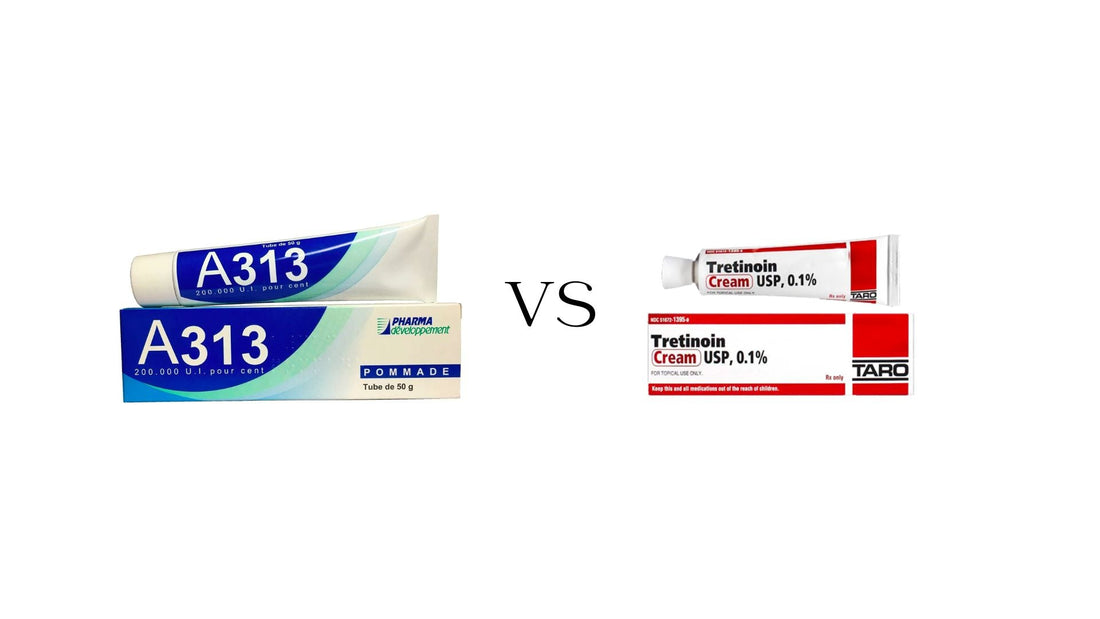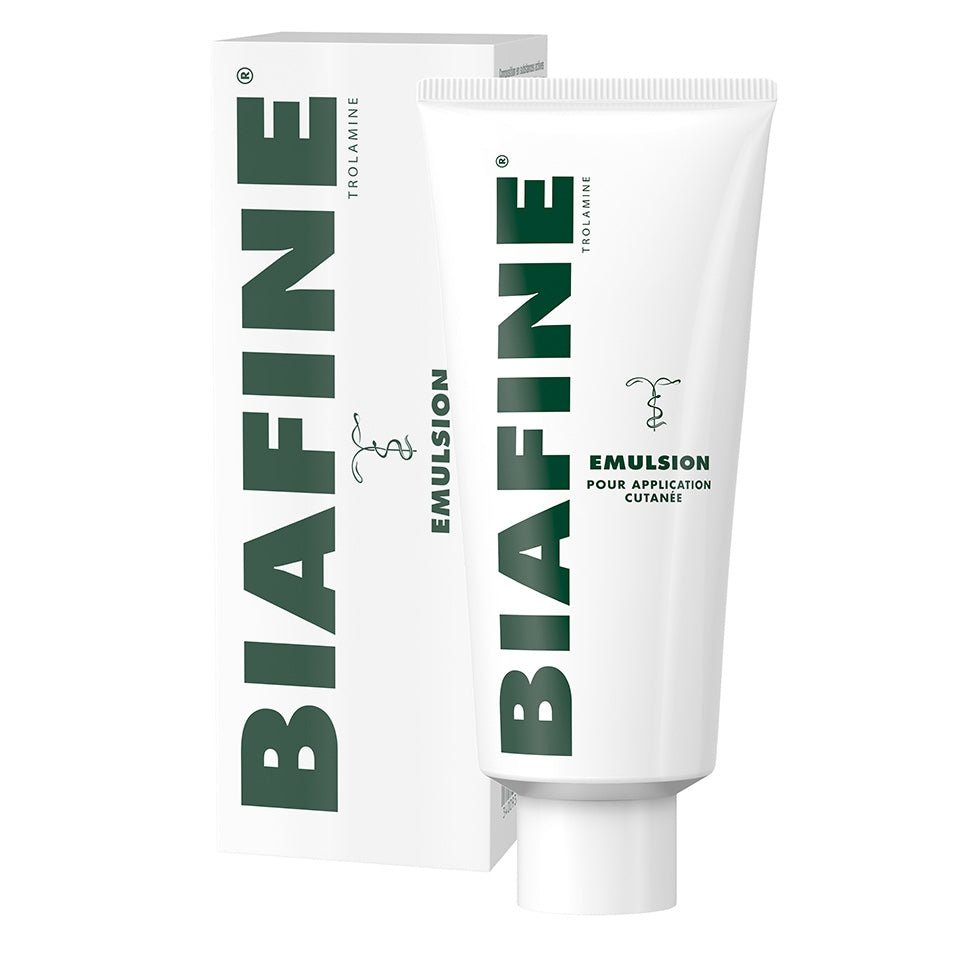
A313 vs Tretinoin - Everything you need to know
Share
Table of Contents
Dive into the world of skincare transformation as we compare A313 and Tretinoin. These two powerhouse ingredients are celebrated for their ability to combat signs of aging and improve skin texture. In this article, we'll break down their differences, helping you determine which one deserves a prime spot in your routine.
Now, let's see if A313 or Tretinoin is the key to healthy, youthful skin.
What is A313?
A313 is a retinol-based cream leveraging vitamin A's renewal power for versatile anti-aging. With a high 0.12% retinol esters concentration, it rivals prescription retinoids. Non-comedogenic, it tackles wrinkles, acne, and uneven skin.
A313 cares beyond ingredients. Emollient elements hydrate and nourish, preventing the dryness often linked to retinol. Unlike prescription retinoids causing initial dryness, A313 ensures a smoother transition.
To incorporate A313, start slow, gradually increasing use. Apply sunscreen daily to shield against UV sensitivity.
It is a very effective anti-aging skincare product.
What is Tretinoin?
Tretinoin, also referred to as a prescription retinoid, comes in the form of a strong topical cream or gel. It's primarily used to address acne, sun damage, and fine wrinkles. The active ingredient is Tretinoin itself, available in varying concentrations such as 0.025% and 0.05%.
Prescription retinoids like Tretinoin function by enhancing cell turnover and encouraging collagen production, resulting in smoother, firmer, and more youthful skin. Unlike over-the-counter retinol products, Tretinoin packs a more powerful punch.
A key distinction between A313 and Tretinoin lies in their accessibility. Tretinoin requires a prescription, allowing dermatologists to customize treatment based on individual needs. Its effectiveness shines through in treating moderate to severe acne and combating signs of aging.
When integrating Tretinoin into your skincare routine, adhering closely to your dermatologist's guidance is crucial. Initial usage may lead to dryness, peeling, and redness, but these effects typically wane as your skin adjusts.
Like A313, sun protection is essential when using Tretinoin. Elevated skin sensitivity due to increased cell turnover necessitates thorough sun shielding. In addition to nightly Tretinoin use, maintaining a consistent daytime routine involving sunscreen and gentle moisturization is key.
A313 and Tretinoin: How to choose?
The decision between A313 and Trettinoin boils down to several factors that are unique to your skincare goals and circumstances. Here are some points to consider when making your choice:
Skin Concerns: If you're primarily addressing mild to moderate skin concerns such as fine lines, texture issues, and minor acne, A313 might be a suitable starting point. For more severe acne and advanced signs of aging, Tretinoin, with its prescription strength, could be the better option.
Access: A313 is more accessible than prescription-only Tretinoin. If you're unable to consult a dermatologist or access prescription skincare, A313 can provide a solid introduction to the benefits of retinoids.
Tolerance: Some individuals may find Tretinoin's strength too harsh for their skin, especially during the initial stages of use. A313, with its slightly milder yet still potent formulation, might be better tolerated by certain skin types.
Combination Approach: Depending on your skin's needs, you could opt for a combination approach. For instance, you might use Tretinoin to target specific problem areas and A313 for overall skin maintenance.
Cost Considerations: A313 is often more budget-friendly than Tretinoin and some other prescription retinoids. If cost is a significant factor, A313 could be a reasonable choice.
Patience and Persistence: Both A313 and Tretinoin require patience and persistence. Results may not be immediate, and adjustments to your skincare routine may be necessary along the way.
Professional Advice: Consulting a dermatologist or skincare professional is invaluable, especially when considering Tretinoin. They can provide personalized recommendations based on your skin's needs and help you navigate potential side effects.
What are the differences between A313 and Tretinoin ?
| A313 | Tretinoin | |
|---|---|---|
| 1 | Retinol-based cream | Prescription retinoid |
| 2 |
High concentration of retinol |
Available in various prescription strengths |
| 3 | Versatile for mild to moderate concerns | Effective for moderate to severe acne |
| 4 | Non-prescription, accessible | Prescription-only |
| 5 | Suitable for fine lines, texture, acne | Addresses advanced signs of aging |
| 6 | Nourishing and hydrating ingredients | Stimulates collagen production |
| 7 | Gradual adjustment for skin tolerance | May cause initial dryness and peeling |
| 8 | Lower cost compared to prescription options | Potent and scientifically proven |
| 9 | Accessible without dermatologist consultation | Requires dermatologist guidance |
| 10 | Beneficial for overall skin maintenance | Tailored treatment for specific skin issues |
Long-Term Effects and Benefits of Retinoids:
Consistency in skincare is often the key to reaping lasting rewards. When it comes to retinol or retinoid usage, the potential for long-term benefits is a remarkable incentive. By incorporating these powerful compounds into your routine over an extended period, you open the door to sustained improvements in skin health. Beyond addressing immediate concerns such as fine lines, uneven texture, and hyperpigmentation, the regular use of retinoids stimulates collagen production. This leads to enhanced skin elasticity and firmness, contributing to a more youthful appearance as the years go by. With diligent application, the cumulative effects become evident, and your complexion can maintain its vibrancy and resilience.
Daytime vs. Nighttime Retinoid Use of Retinoids:
The timing of retinoid application can significantly influence their effectiveness and potential side effects. The debate between daytime and nighttime usage hinges on crucial factors. Nighttime application is favored due to the skin's natural repair processes during sleep. This is when retinoids can work their magic with less interference from external factors. Nighttime use also minimizes sun sensitivity, a common side effect of retinoids. However, some individuals may find daytime application more practical, and it's still effective if coupled with thorough sun protection. Applying retinoids during the day requires the diligent use of broad-spectrum sunscreen with at least SPF 30 to shield your skin from heightened sensitivity to UV rays. Balancing these considerations can help you decide the best time to incorporate retinoids into your routine.
10 myths about Retinoids:
Misconceptions about retinoids have led to uncertainty and hesitancy among skincare enthusiasts. It's time to set the record straight by addressing a comprehensive list of myths and debunking them with accurate information:
-
Retinoids Thin the Skin Permanently: This myth likely stems from the initial dryness and peeling that can occur when starting retinoid use. However, this effect is temporary and often followed by improved skin thickness due to increased collagen production.
-
Retinoids are Only for Mature Skin: Retinoids can benefit various age groups. They not only target fine lines and wrinkles but also help manage acne, refine skin texture, and improve overall skin health.
-
Retinoids Shouldn't be Used with Other Active Ingredients: While caution is necessary when combining strong actives, retinoids can work synergistically with other ingredients when used thoughtfully in a well-rounded routine.
-
Retinoids Make Your Skin Photosensitive 24/7: While retinoids do increase sun sensitivity, this effect is more pronounced shortly after application. Nighttime use can mitigate daytime sun sensitivity, and sunscreen is essential during the day.
-
Higher Concentrations Yield Better Results: More isn't always better. Higher concentrations of retinoids can lead to increased irritation without necessarily providing superior results. Gradual introduction is key.
-
Retinoids Are Only for Certain Skin Types: Retinoids can be adapted to different skin types. Proper introduction and moisturization can help individuals with sensitive or dry skin tolerate retinoids.
-
Retinoids Exclusively Exfoliate: While retinoids do encourage exfoliation, their primary mode of action is stimulating cell turnover and collagen production, contributing to overall skin health.
-
You Can't Use Retinoids with Acids: While it's important to use caution, some acids can complement retinoid benefits. Consultation with a skincare professional is advisable for personalized guidance.
-
Retinoids Work Instantly: Visible improvements from retinoids take time. Patience is necessary as cellular turnover processes gradually reveal smoother and clearer skin.
- Retinoids are Unnecessary if You Don't Have Wrinkles: Retinoids offer a wide range of benefits beyond wrinkle reduction, including managing acne, refining pores, and enhancing skin texture.
In Summary
When it comes to choosing between "A313 vs Tretinoin," the answer isn't one-size-fits-all. Both products, with their retinol-based formulas, offer great benefits. But if we're talking about convenience, safety, and versatility, A313 emerges as the better choice for many.
If you're new to retinol and dealing with mild skin concerns, A313 is your go-to. It's easy to access and doesn't require a prescription. Whether your skin is oily, dry, or in between, A313 caters to all types, making it a user-friendly option. You can also combine A313 with Ialuset for better results.
On the other hand, if you're ready for a prescription-strength routine and more intense skincare goals, Tretinoin can be considered under dermatologist guidance.
Remember, the key to radiant and youthful skin lies in consistency, sun protection, and a healthy routine. Whether you choose A313 or another option, approach your skincare journey with patience and enjoy the self-care that comes with it. Your skin deserves the best!



